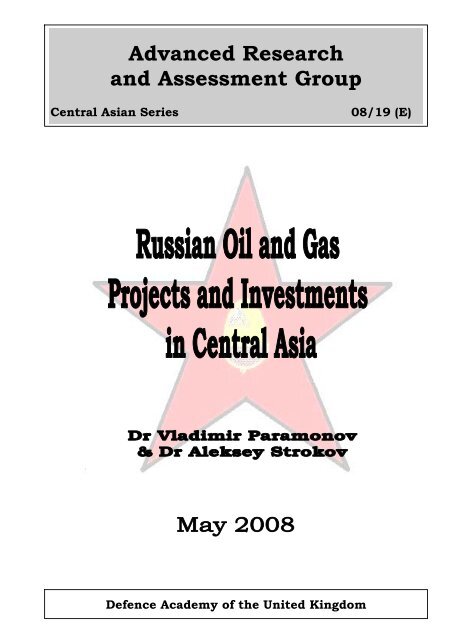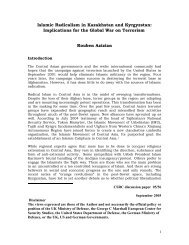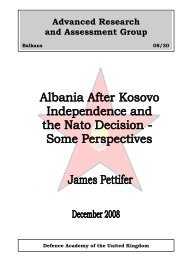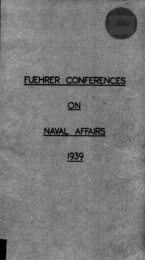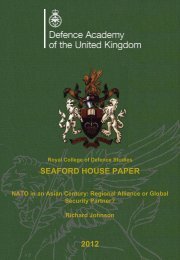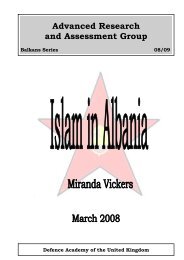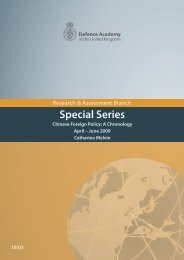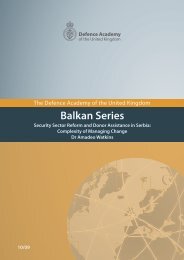Advanced Research and Assessment Group - Defence Academy of ...
Advanced Research and Assessment Group - Defence Academy of ...
Advanced Research and Assessment Group - Defence Academy of ...
You also want an ePaper? Increase the reach of your titles
YUMPU automatically turns print PDFs into web optimized ePapers that Google loves.
ContentsIntroduction 11. Present situation 1Kazakhstan 2Turkmenistan 5Uzbekistan 7Tajikistan 8Kyrgyzstan 92. New trends 10The rise <strong>of</strong> Kazakhstan as an independent playerin the oil <strong>and</strong> gas sectors 10The development <strong>of</strong> LNG, alternative ways<strong>of</strong> transporting hydrocarbons 11Forming alliances 11Conclusions 12
Russian Oil <strong>and</strong> GasProjects <strong>and</strong> Investments in Central AsiaDr Vladimir Paramonov <strong>and</strong> Dr Aleksey Strokov08/19 (E)IntroductionIn the 1990s Russian investments were mainly in Kazakhstan, in the “Tengiz-Novorossiysk” oil pipeline <strong>and</strong> the opening <strong>of</strong> the “Karachaganak” gas condensatefield. The interest <strong>of</strong> Russia in the other countries <strong>of</strong> Central Asia remainedminimal. With the coming to power <strong>of</strong> Vladimir Putin in 2000 <strong>and</strong> the steady rise <strong>of</strong>prices for hydrocarbons, the importance to Moscow <strong>of</strong> the Central Asian region grewsharply. A consequence <strong>of</strong> this was the marked increase in activity <strong>of</strong> Russia <strong>and</strong>Russian oil <strong>and</strong> gas companies, not only in Kazakhstan but now also inTurkmenistan <strong>and</strong> Uzbekistan. Furthermore, it is typical that recently Moscow hasbegun to show a greater interest in two other states <strong>of</strong> the region – Kyrgyzstan <strong>and</strong>Tajikistan, notwithst<strong>and</strong>ing their minimal oil <strong>and</strong> gas potential.Against this background, the project <strong>and</strong> investment activity <strong>of</strong> individual countries<strong>of</strong> Central Asia in the oil <strong>and</strong> gas sectors <strong>of</strong> Russia remains extremely low for thetime being. The single exception is the Russo-Kazakh project on the Orenburg(Russia) gas processing facility for the processing <strong>of</strong> Kazakh raw material <strong>and</strong> thejoint sale <strong>of</strong> natural gas on external markets. In its turn, investment cooperation inthe oil <strong>and</strong> gas sphere between the individual countries <strong>of</strong> Central Asia also remainsweak for the time being, although in the coming years one can expect an increase inKazakh activity in the oil <strong>and</strong> gas sectors <strong>of</strong> the other regional states.1. Present SituationAt present, Russian strategic interests mainly concern the three Central Asianstates that possess commercial reserves <strong>of</strong> hydrocarbons: Kazakhstan,Turkmenistan <strong>and</strong> Uzbekistan. As yet no reserves <strong>of</strong> hydrocarbons in commercialquantities have been discovered in the other two countries <strong>of</strong> the region – Tajikistan<strong>and</strong> Kyrgyzstan, <strong>and</strong> for this reason Russian interests there are little concernedwith questions <strong>of</strong> extracting <strong>and</strong> importing hydrocarbons but are mainly aimed atopening the market for petroleum products.At the end <strong>of</strong> 2007, the total volume <strong>of</strong> Russian investments in the oil <strong>and</strong> gassectors in the countries <strong>of</strong> Central Asia was between 4 <strong>and</strong> 5.2 billion dollars. 1 Byfar the greatest share (in the order <strong>of</strong> 80-85%) is concentrated in Kazakhstan (fromapproximately 3.4 to 4.1 billion dollars); there is a smaller share in Uzbekistan(from 0.5 to 1 billion dollars) <strong>and</strong> a so far insignificant amount in Turkmenistan,Tajikistan <strong>and</strong> Kyrgyzstan (50 million dollars in total). Russian companies aim toinvest approximately between 14 <strong>and</strong> 16 billion dollars over the next five years:Russian Oil <strong>and</strong> Gas Projects <strong>and</strong> Investments in Central Asia<strong>Advanced</strong> <strong>Research</strong> <strong>and</strong> <strong>Assessment</strong> <strong>Group</strong>ISBN 978-1-905962-51-8May 20081
08/19 (E) Dr Vladimir Paramonov & Dr Aleksey Strokovprimarily in the search for <strong>and</strong> development <strong>of</strong> oil <strong>and</strong> natural gas fields throughoutCentral Asia, but also in the pipeline infrastructure <strong>of</strong> the region.The interest in Central Asia is to a large extent explained by the fact that theextraction <strong>of</strong> hydrocarbons in the conditions <strong>of</strong> the region is technically simpler <strong>and</strong>economically more advantageous than in the north <strong>of</strong> Russia where theoverwhelming majority <strong>of</strong> Russian oil <strong>and</strong> gas fields are concentrated. Russia isstriving to drag as large a part as possible <strong>of</strong> the hydrocarbon resources <strong>of</strong> CentralAsia into its own fuel-energy balances in order to support internal consumption,without simultaneously lowering the volumes <strong>of</strong> its own hydrocarbon exports toexternal markets, first <strong>and</strong> foremost to Europe.Kazakhstan 2Russian companies such as Lukoil, Gazprom <strong>and</strong> Rosneft are active in Kazakhstanat the present time. At the end <strong>of</strong> 2007, total Russian investments in the oil <strong>and</strong>gas sectors <strong>of</strong> Kazakhstan amounted to an estimated 3.4 to 4.1 billion dollars. Bythe end <strong>of</strong> 2012, Russia plans to invest an additional sum <strong>of</strong> between 6.7 <strong>and</strong> 7.5billion dollars. It is suggested that this will be mainly invested in geological surveyprojects <strong>and</strong> the opening <strong>of</strong> promising oil <strong>and</strong> gas fields as well as in thedevelopment <strong>of</strong> the pipeline system.Projects for Geological Survey <strong>and</strong> Development <strong>of</strong> Oil <strong>and</strong> Gas FieldsDevelopment 3 <strong>of</strong> the “Karachaganak” gas condensate field (Province <strong>of</strong> WesternKazakhstan in northwestern Kazakhstan). This field is one <strong>of</strong> the largest inKazakhstan: proven reserves comprise about 1.35 trillion m³ <strong>of</strong> natural gas <strong>and</strong> 1.2billion tonnes <strong>of</strong> oil. From 1997 to 2037, companies from several countries areinvolved in working the field. Russia’s Lukoil has a 15% share (750 million dollars).Development <strong>of</strong> the “Kumkol Severnyy” oil <strong>and</strong> gas field (Kyzylorda province incentral southern Kazakhstan). Reserves <strong>of</strong> oil are estimated to be 42 million tonnes<strong>and</strong> 4.5 billion m³ <strong>of</strong> gas. The working <strong>of</strong> the field began in 1996 by Turgai-Petroleum Ltd (traded as Kumkol-Lukoil Ltd until 2000), now owned on a paritybasis by the Kazakh-Sino PetroKazakhstan 4 <strong>and</strong> Lukoil.Development <strong>of</strong> the “Severnyye Buzachi” oilfield (Mangistau province in westernKazakhstan). Estimated oil reserves are approximately 80 million tonnes. Theworking <strong>of</strong> the oilfield began in 1999. Since 2003, this field has been owned on aparity basis by the Canadian company Nelson Resources <strong>and</strong> the Chinese NationalPetroleum Company. In 2005, Lukoil acquired 100% <strong>of</strong> the shares <strong>of</strong> NelsonResources for two billion dollars. 5Development <strong>of</strong> the “Alibekmola” <strong>and</strong> “Kozhasai” oil <strong>and</strong> gas condensate field(Aktobe province in the north–western part <strong>of</strong> Kazakhstan). Oil reserves <strong>of</strong> thesefields are estimated at 70 million tonnes with approximately 13 thous<strong>and</strong> tonnes <strong>of</strong>gas condensate. The Kazakh state company Kazakhoil-Aktobe began working the“Alibekmola” field in 2001 <strong>and</strong> the “Kozhasai” field in 2003. In 2000 after openingthe above fields, Kazakhoil-Aktobe sold 50% <strong>of</strong> its assets to the Canadian companyNelson Resources, which became a subsidiary enterprise <strong>of</strong> Lukoil in 2005.Development <strong>of</strong> the “Karakuduk” oilfield (Mangistau province, westernKazakhstan). Oil reserves are estimated at approximately 45 million tonnes, whichhave, since 2000, been worked by Karakudukmunay (100% subsidiary <strong>of</strong> Lukoil).2
Russian Oil <strong>and</strong> Gas Projects <strong>and</strong> Investments in Central Asia08/19 (E)Geological survey <strong>and</strong> subsequent development <strong>of</strong> the oil <strong>and</strong> gas condensatefields “Tyub-Karagan” <strong>and</strong> “Atashskaya” (central part <strong>of</strong> the Kazakh section <strong>of</strong>the Caspian Sea <strong>of</strong>fshore shelf). Reserves <strong>of</strong> oil (including gas condensate) <strong>of</strong> the“Tyub-Karagan” field are estimated at 324 million tonnes <strong>of</strong> ideal crude, <strong>and</strong> <strong>of</strong> the“Atashkaya” field at 249 million tonnes. The project is being managed by Lukoiltogether with the Kazakh Maritime Oil Company KazMunayTeniz (100% subsidiary<strong>of</strong> KazMunayGaz) from 2003 to 2043. Drilling <strong>of</strong> the first exploratory wells isplanned between 2008 <strong>and</strong> 2010.Geological survey <strong>and</strong> subsequent development <strong>of</strong> the “Kurmangazy” oil <strong>and</strong>gas condensate field (southern part <strong>of</strong> the Kazakh section <strong>of</strong> the Caspian Sea<strong>of</strong>fshore shelf). Estimates <strong>of</strong> the reserves <strong>of</strong> oil <strong>and</strong> gas condensate <strong>of</strong> the field varywidely, from 500 million tonnes to 1.8 billion tonnes. The work is being carried outby Rosneft together with the Kazakh Ministry <strong>of</strong> Energy <strong>and</strong> Mineral Resources,over the period 2005-2060. Drilling <strong>of</strong> the first exploratory wells on the field isplanned to be done by 2012.Geological survey <strong>and</strong> subsequent development <strong>of</strong> the “Zhambay” oil <strong>and</strong> gasfield (on the Caspian Sea <strong>of</strong>fshore shelf). As yet, reserves <strong>of</strong> oil <strong>and</strong> gas areunknown. In 2006, agreement was reached for KazMunayGaz to transfer 25%shares in the project each to Lukoil <strong>and</strong> Spanish Repsol. Up to <strong>and</strong> including 2007,a seismographic survey <strong>of</strong> the fields was conducted, the results <strong>of</strong> which areundergoing analysis. Preparatory works <strong>and</strong> drilling <strong>of</strong> the first exploratory well areplanned for 2008-2009.Preparation for geological survey <strong>and</strong> subsequent development <strong>of</strong> the“Imashevskoe” gas condensate field (Atyrau province, western Kazakhstan <strong>and</strong>Astrakhan province, Russia). Reserves are estimated at 129 billion m³ <strong>of</strong> naturalgas <strong>and</strong> 21 million tonnes <strong>of</strong> gas concentrate. 6 Work on the oilfield should begin inthe near future. The Kazakh part <strong>of</strong> the work will be carried out by KazMunayGaz,but a Russian developer (with rights to subsoil use) has not yet been identified.Preparation for geological survey <strong>and</strong> subsequent development <strong>of</strong>“Khvalinskoe” <strong>and</strong> “Tsentralnoe” oil <strong>and</strong> gas fields (northern Caspian, Russian<strong>and</strong> Kazakh sections <strong>of</strong> the <strong>of</strong>fshore shelf). Hydrocarbon reserves <strong>of</strong> “Khvalinskoe”are estimated at 480 million tonnes <strong>of</strong> oil equivalent, including 300 million tonnes<strong>of</strong> oil; 7 “Tsentralnoe” is estimated to contain 522 million tonnes <strong>of</strong> oil <strong>and</strong> 92 billionm³ <strong>of</strong> associated petroleum gas. 8 Work on the fields has not yet started but shouldbegin in 2008. The Kazakh part <strong>of</strong> the work will be carried out by KazMunayGaz.The Russian work on “Khvalinskoe” oilfield will be done by Lukoil <strong>and</strong> on the“Tsentralnoe” field by Lukoil <strong>and</strong> Gazprom.Projects for Processing Raw GasJoint gas <strong>and</strong> gas condensate processing at the Orenburg (Russia) gasprocessing plant (GPZ). In October 2006, Russia <strong>and</strong> Kazakhstan signed an intergovernmentalagreement on the creation <strong>of</strong> a joint venture to process gas at thisGPZ. The project is being implemented by Gazprom <strong>and</strong> KazMunayGaz. In 2007, apurchase-sale agreement was signed for the delivery <strong>of</strong> gas from“Karachaganakskoe” to the Orenburg GPZ for 15 years (2007-2022). It is expectedthat until 2010 the rate <strong>of</strong> gas processing will be 8 billion m³, in 2011 it will be 12billion m³ 9 <strong>and</strong> from 2012, not less than 15 billion m³ annually.3
08/19 (E) Dr Vladimir Paramonov & Dr Aleksey StrokovPreparations for the building <strong>of</strong> a Caspian gas-chemical complex (GKKh) nearthe "Khvalinskoe” oil <strong>and</strong> gas field (Atyrau province, western Kazakhstan). In2006, a working group <strong>of</strong> representatives from KazMunayGaz <strong>and</strong> Lukoil wasformed to manage the construction project. It is planned that the GKKh willprocess approximately 14 billion m³ <strong>of</strong> gas annually. Matters relating to theRussian <strong>and</strong> Kazakh percentage shares in the project are being resolved <strong>and</strong> thetimelines <strong>of</strong> the development are also the subject <strong>of</strong> discussions.Pipeline ProjectsPreparations for upgrading the throughput capacity <strong>of</strong> the oil pipeline“Atyrau-Samara”. 10 The project is being implemented on the basis <strong>of</strong> the intergovernmentalagreement on oil transfer signed between Russia <strong>and</strong> Kazakhstan in2002. The operator <strong>of</strong> the Kazakh section will be the National Oil TransportationCompany KazTransOil. The operator <strong>of</strong> the Russian section will be Transneft.By 2017 (expiry <strong>of</strong> the agreement on oil transfer) Russia <strong>and</strong> Kazakhstan plan toincrease the throughput capacity <strong>of</strong> the oil pipeline from the present 15 to 25million tonnes annually. 11 Terms <strong>and</strong> conditions <strong>of</strong> the agreement package on theproject to exp<strong>and</strong> the pipeline are under negotiation. It is proposed that part <strong>of</strong> theoil (some 17 million tonnes from Kazakhstan alone) will go via the planned “Burgas-Alex<strong>and</strong>roupolis” pipeline (Bulgaria-Greece), avoiding the Turkish straits. 12Planned increase in throughput capacity <strong>of</strong> the “Tengiz-Novorossiysk” oilpipeline. 13 The operator <strong>of</strong> the pipeline will be the Caspian Pipeline Consortium(CPC). The Russian state share in CPC is 24% (625 million dollars), while Russiancompanies own a further 20% (520 million dollars). 14 Russia <strong>and</strong> Kazakhstan planto increase the throughput capacity <strong>of</strong> the pipeline from the present 32 to 67 milliontonnes per year (including up to 50 million tonnes <strong>of</strong> Kazakh oil). 15 However, theprospects <strong>and</strong> outline dates for completion <strong>of</strong> the project to increase throughputcapacity are unclear as yet.Collaboration on the transfer <strong>of</strong> Turkmen <strong>and</strong> Uzbek gas through the “CentralAsia-Centre” [Russian acronym SATs] 16 <strong>and</strong> “Bukhara-Ural” 17 pipelines <strong>and</strong> alsothe transfer <strong>of</strong> Russian gas via the “Orenburg-Novopskov” <strong>and</strong> “Soyuz” pipelines. 18The above cooperation is proceeding on the basis <strong>of</strong> the 2001 international basetreaty on collaboration in the gas sector. In 2005, two medium-term agreementscovering 2006-2010 were signed between Gazprom <strong>and</strong> the operator <strong>of</strong> the Kazakharterial gas pipelines, the “Intergaz Central Asia” company (100% owned subsidiary<strong>of</strong> KaztransGaz). The first determined a rise by 2010 in the volume <strong>of</strong> Russian gasbeing transferred across the Ural province <strong>of</strong> Kazakhstan to 70 billion m³ annuallythrough the “Soyuz” <strong>and</strong> “Orenburg-Novopskov” pipelines. 19 The second agreementprovided for volumes <strong>of</strong> transfer <strong>of</strong> up to 55 billion m³ <strong>of</strong> Central Asian gas acrossKazakh territory via the SATs system annually. 20Today, the actual throughput capacity <strong>of</strong> the Kazakh section <strong>of</strong> the SATs gaspipeline is roughly about 60 billion m³ annually. The “Bukhara-Ural” pipeline cantransfer up to 7 billion m³, while the “Orenburg-Novopskov” <strong>and</strong> “Soyuz” pipelines(aggregated) can carry 47 billion m³. By 2010, following modernisation <strong>of</strong> the SATsgas pipeline, Kazakhstan plans to increase its throughput capacity to 80 billion m³per annum, <strong>and</strong> in the near future even up to 100 billion m³.As a whole, all modernisation work on the arterial gas pipelines traversingKazakhstan is being executed by KazMunayGaz <strong>and</strong> KazTransGaz independently,4
Russian Oil <strong>and</strong> Gas Projects <strong>and</strong> Investments in Central Asia08/19 (E)without investment or other participation <strong>of</strong> Russia or Russian companies.However, inasmuch as the Kazakh gas transportation system is objectively acomponent part <strong>of</strong> the gas transportation system <strong>of</strong> the whole post-Soviet space,then cooperation with Russia on matters <strong>of</strong> gas transfer is realistically unavoidable.Plans to link up “Druzhba” <strong>and</strong> “Adriya” oil pipelines. 21 Moscow <strong>and</strong> Astana arenow examining the possibility <strong>of</strong> creating a new export route for the transfer <strong>of</strong> oilfrom Russia <strong>and</strong> Kazakhstan to world markets through Europe <strong>and</strong> the sea port <strong>of</strong>Omishal (Croatia). It is planned that after the oil pipelines “Druzhba” <strong>and</strong> “Adriya”are joined up the oil export volumes from Russia <strong>and</strong> Kazakhstan to Europe willincrease by 15 million tonnes <strong>of</strong> oil annually. However the prospects <strong>and</strong> outlinedates <strong>of</strong> the venture are still unclear.Projects for Sales <strong>of</strong> Petroleum ProductsGazprom plans to develop the Kazakh market for petroleum products with its ownproduction. Gazprom Neft (a Gazprom subsidiary) leases 11 oil depots inKazakhstan <strong>and</strong> intends to exp<strong>and</strong> its network <strong>of</strong> fuel stations. From 2008,Gazprom plans to supply approximately 25 – 30 thous<strong>and</strong> tonnes <strong>of</strong> petroleumproducts monthly <strong>and</strong>, correspondingly, 300 – 620 thous<strong>and</strong> tonnes annually.According to preliminary calculations, this will allow Gazprom to secure about 3%<strong>of</strong> the Kazakh market for petroleum products. 22Turkmenistan 23At present, such companies as Gazprom <strong>and</strong> the ITERA International <strong>Group</strong> <strong>of</strong>Companies are working in Turkmenistan. Project <strong>and</strong> investment activity <strong>of</strong> Russia<strong>and</strong> Russian companies in the oil <strong>and</strong> gas sectors <strong>of</strong> Turkmenistan is still extremelylow; it encompasses only the gas transportation area <strong>and</strong> the volume <strong>of</strong> Russianinvestments at the end <strong>of</strong> 2007 was barely in the region <strong>of</strong> 25 million dollars. 24These investments were directed towards the supply from Russia <strong>of</strong> technicalequipment for the gas sector <strong>of</strong> Turkmenistan, the renovation <strong>and</strong> modernization <strong>of</strong>gas pipelines, compression <strong>and</strong> distribution stations, etc.Nevertheless, considering the significant hydrocarbon <strong>and</strong>, above all, the gasreserves <strong>of</strong> Turkmenistan, one can with great certainty assume that in the nearfuture the investment activity <strong>of</strong> Russian companies will increase dramatically. Upto <strong>and</strong> including 2012, Gazprom alone plans to invest not less than 2 billion dollarsin the gas sector <strong>of</strong> Turkmenistan (primarily in the development <strong>of</strong> gas fields, butalso in the expansion <strong>of</strong> the SATs arterial pipeline). 25 Furthermore, it is most likelythat other Russian or joint companies can be expected to appear in Turkmenistan,in the first instance Lukoil <strong>and</strong> TNK–BP.At the present time, Russia does not yet have any actual projects in the oil <strong>and</strong> gassectors <strong>of</strong> Turkmenistan, if cooperation on matters relating to the supply <strong>of</strong>Turkmen gas to Russia <strong>and</strong> in the direction <strong>of</strong> Russia is not considered as a“project”. Considering that the export potential <strong>of</strong> oil from Turkmenistan isinsignificant <strong>and</strong> is <strong>of</strong> no importance to Russia, Russian interests in Turkmenistanare limited to the gas sector. At present Gazprom is linking the possibility <strong>of</strong><strong>of</strong>fering investments with control <strong>of</strong> the Turkmen national gas transportationsystem. 26 In May 2007, Gazprom had already secured agreement to havetransferred to it 27 the operational control functions <strong>of</strong> the pipeline on the Turkmen5
08/19 (E) Dr Vladimir Paramonov & Dr Aleksey Strokovsection <strong>of</strong> the regional gas transportation system (following modernisation <strong>and</strong>expansion).In addition, the following are Moscow’s priority project directions:Modernization <strong>of</strong> Turkmen gas infrastructure. It is planned to implement theproject in accordance with the “Agreement on Gas Sector Cooperation” (2003-28)which in part proposes construction <strong>of</strong> modern equipment for improving the quality<strong>of</strong> natural gas. However, the type, scale <strong>and</strong> timelines <strong>of</strong> the undertaking are notyet clear.Modernization <strong>and</strong> increase <strong>of</strong> throughput capacity <strong>of</strong> the SATs gas pipeline.This project, like the previous one, is proposed for implementation in accordancewith the “Agreement on Gas Sector Cooperation”.Bearing in mind that Russia attaches exceptionally great importance to increasingthe volumes <strong>of</strong> imported Turkmen gas, the major expansion <strong>of</strong> gas transportationcapabilities <strong>of</strong> Turkmenistan in the direction <strong>of</strong> Russia is crucially important. Thethroughput capacity <strong>of</strong> the Turkmen section <strong>of</strong> SATs today is about 50 billion m³per year <strong>and</strong> it has practically reached full capacity. However, the nature, scale<strong>and</strong> timelines for the project <strong>of</strong> reconstruction <strong>and</strong> modernization <strong>of</strong> the Turkmengas pipelines with Russian participation are as yet unclear.Apart from this, ITERA is at present planning the implementation <strong>of</strong> a project toopen a number <strong>of</strong> oil <strong>and</strong> gas fields in Turkmenistan. Today, ITERA is the onlyRussian company to be allowed to develop Turkmen hydrocarbon fields on l<strong>and</strong>. Atthe end <strong>of</strong> 2007 in Ashgabad (Turkmenistan), the Turkmen President, GBerdymukhamedov, held talks with the Chairman <strong>of</strong> the Board <strong>of</strong> Directors <strong>of</strong>ITERA, I Makarov, during which a number <strong>of</strong> subjects were discussed, including theprospects for developing oil <strong>and</strong> gas fields in the Central Karakum <strong>and</strong> on theCaspian Sea <strong>of</strong>fshore shelf. It is believed that the relevant agreement between theTurkmen government <strong>and</strong> ITERA could be signed soon. ITERA has obviousadvantages over remaining Russian companies, as it has been active in the countrysince 1994 <strong>and</strong> owns assets in various business sectors <strong>of</strong> Turkmenistan (not justin the oil <strong>and</strong> gas sectors). 28On the whole it would not be an exaggeration to say that for the time being one canonly discuss Russian project <strong>and</strong> investment activity in the oil <strong>and</strong> gas sectors <strong>of</strong>Turkmenistan in the future tense. This is linked to the fact that the extraction <strong>of</strong>hydrocarbons on l<strong>and</strong> has until now been controlled by the Turkmen government(the only exceptions were made for the Chinese CNPC, ITERA <strong>and</strong>, possibly, mightbe made for the Kazakh KazMunayGaz). Foreign investors only have access to thedevelopment <strong>of</strong> the <strong>of</strong>fshore shelf oilfields on the Turkmen section <strong>of</strong> the CaspianSea littoral under production sharing agreement conditions.On the whole, however, Russian companies are not showing any special interest inthe development <strong>of</strong> the <strong>of</strong>fshore oil <strong>and</strong> gas fields. This is largely because the<strong>of</strong>fshore fields that interest Russia are found near the Turkmen-Iranian maritimeborder. The status <strong>of</strong> the Caspian Sea has not yet been defined, <strong>and</strong> Iran isinsisting on an increase in the size <strong>of</strong> its section. In addition, the opening <strong>of</strong><strong>of</strong>fshore fields is technically more difficult than on l<strong>and</strong> <strong>and</strong> is therefore moreexpensive.6
Russian Oil <strong>and</strong> Gas Projects <strong>and</strong> Investments in Central Asia08/19 (E)Uzbekistan 29At present Russian companies such as Gazprom <strong>and</strong> Lukoil are active inUzbekistan. At the end <strong>of</strong> 2007, Russian investments in the oil <strong>and</strong> gas sectors <strong>of</strong>Uzbekistan amounted to between 520 <strong>and</strong> 1050 million dollars. By 2012, Russiaplans to invest a suggested 4.7 to 6.2 billion dollars into the oil <strong>and</strong> gas sectors <strong>of</strong>Uzbekistan. These resources are to be put into geological survey <strong>and</strong> opening <strong>of</strong> oil<strong>and</strong> gas fields projects as well as into the modernization <strong>of</strong> pipeline infrastructure.Projects for Geological Survey <strong>and</strong> Development <strong>of</strong> Oil <strong>and</strong> Gas FieldsDevelopment <strong>of</strong> “Shakhpakhty” gas condensate field (Karakalpakstan Republic,Ustyurt Plateau, western Uzbekistan). The field was discovered in 1962 <strong>and</strong> itscommercial reserves are estimated at approximately 46.5 billion m³ <strong>of</strong> gas(including gas condensate) <strong>and</strong> 7.7 million tonnes <strong>of</strong> oil. The field is beingdeveloped by Gazprom <strong>and</strong> the National Holding Company “Uzbekneftegaz” over2004–19.Development <strong>and</strong> geological survey <strong>of</strong> the “K<strong>and</strong>ym – Khauzak – Shady” gascondensate fields (Bukhara province, central Uzbekistan) <strong>and</strong> the “Kungrad”field (Karakalpakstan Republic). Overall gas reserves <strong>of</strong> these fields are assessedas approximately 283 – 329 billion m³ (the largest fields <strong>of</strong> the K<strong>and</strong>ym group areestimated at over 150 billion m³) with oil reserves <strong>of</strong> 8 million tonnes. Developmentwork is being carried out by Lukoil <strong>and</strong> Uzbekneftegaz over 2004–39. Extraction <strong>of</strong>raw gas <strong>and</strong> delivery to the Mubarek gas processing plant (Uzbekistan) began fromthe “Khauzak” field at the end <strong>of</strong> 2007.Geological survey <strong>and</strong> subsequent development <strong>of</strong> the “Zhambay” oil <strong>and</strong> gasfields in the Uzbek section <strong>of</strong> the Aral Sea. The gas reserves <strong>of</strong> these fields areestimated at approximately 1 trillion m³ with somewhere in the region <strong>of</strong> 150 milliontonnes <strong>of</strong> oil. The project is being implemented over 2005–40 by an internationalconsortium that includes Lukoil which owns 10% <strong>of</strong> the overall future yield.Exploration <strong>and</strong> subsequent development <strong>of</strong> a series <strong>of</strong> oil <strong>and</strong> gas fields in thesouth western part <strong>of</strong> Gissar Region (on the border between the Kashkadarya <strong>and</strong>Surkh<strong>and</strong>arya provinces, southern Uzbekistan, near Karshi City) <strong>and</strong> CentralUstyurt (Karakalpakstan Republic). Estimated reserves <strong>of</strong> gas <strong>of</strong> these fields (twooil <strong>and</strong> seven gas condensate fields) are in the region <strong>of</strong> 150 billion m³ <strong>of</strong> gas <strong>and</strong>approximately 50 million tonnes <strong>of</strong> oil. 30 The project is run by the RussianInvestment <strong>and</strong> Financial <strong>Group</strong> SoyuzNefteGaz <strong>and</strong> Uzbekneftegaz over 2007–48.In February 2008, Lukoil acquired controlling shares in SoyuzNefteGaz, includingthe latter’s projects in Uzbekistan.Exploration <strong>of</strong> a series <strong>of</strong> other gas condensate fields on the Ustyurt Plateau.Projected reserves <strong>of</strong> only a few <strong>of</strong> the largest fields (“Urga”, “Kuanysh” <strong>and</strong> theAkhchalak group) are estimated to be in the region <strong>of</strong> 1 – 1.27 trillion m³ <strong>of</strong> gas.Since 2007, Gazprom, on the basis <strong>of</strong> agreements signed in 2006 with the Uzbekgovernment <strong>and</strong> Uzbekneftegaz 31 has been carrying out geological studies <strong>of</strong> seveninvestment blocks on the Ustyurt Plateau.7
08/19 (E) Dr Vladimir Paramonov & Dr Aleksey StrokovProjects for Processing <strong>of</strong> Raw GasPlans for the production <strong>of</strong> liquefied gas <strong>and</strong> benzine at the Mubarek gasprocessing plant (GPZ) (Mubarek, Uzbekistan). The project was implemented in2006 by Gazprom <strong>and</strong> Uzbekneftegaz as a joint venture <strong>and</strong> anticipates theconstruction <strong>and</strong> operation <strong>of</strong> production facilities to process 12 billion m³ <strong>of</strong> gasannually. Apart from marketable methane (the major component in volume <strong>of</strong>natural gas) the GPZ will produce approximately 270,000 tonnes <strong>of</strong> liquefied gas<strong>and</strong> 70,000 tonnes <strong>of</strong> stable gas condensate. 32 Production is expected to start in2009.Preparations for the construction <strong>of</strong> the K<strong>and</strong>ym gas processing works (GPK)near the “K<strong>and</strong>ym” field. This is a Lukoil project with the first part <strong>of</strong> the GPKexpected to come on stream by 2011 with a capacity <strong>of</strong> 6 to 8 or, according to someassessments, up to 10 billion m³ annually.Pipeline ProjectsCooperation on the transfer <strong>of</strong> Turkmen <strong>and</strong> supply <strong>of</strong> Uzbek gas. This projectis being implemented by Uztransgaz (subsidiary <strong>of</strong> Uzbekneftegaz) on the basis <strong>of</strong> a2005 agreement between Gazprom <strong>and</strong> Uztransgaz for the years 2006–10. The aim<strong>of</strong> the agreement was to organize the supply <strong>of</strong> Central Asian gas (fromTurkmenistan <strong>and</strong> Uzbekistan) using the SATs <strong>and</strong> “Bukhara-Ural” gastransportation systems, that both cross Uzbekistan. The whole <strong>of</strong> the Uzbek gastransportation system (SATs-1, 2, 3, 4, 5 <strong>and</strong> “Bukhara-Ural” is in a satisfactorycondition, <strong>and</strong> is capable <strong>of</strong> transferring not less than 55 billion m³ annually.Plans to modernize <strong>and</strong> increase the throughput capacity <strong>of</strong> the Uzbeksections <strong>of</strong> the gas pipelines SATs <strong>and</strong> “Bukhara-Ural”. 33 Work on expansion<strong>and</strong> repair <strong>of</strong> the Uzbek sections <strong>of</strong> the SATs <strong>and</strong> “Bukhara-Ural” pipelines arecarried out regularly by Uztransgaz. Gazprom intends to increase the throughputcapacity <strong>of</strong> the Uzbek sections <strong>of</strong> these arterial gas pipelines, however, neither thenature nor the timelines for possible activity on Uzbek territory are yet clear. As aresult the future throughput capacity <strong>of</strong> the Uzbek sections <strong>of</strong> the SATs <strong>and</strong>“Bukhara-Ural” pipelines is unclear.TajikistanAt present, Gazprom is the only real presence in Tajikistan. So far, no significantcommercial reserves <strong>of</strong> oil <strong>and</strong> gas have been revealed. The high price <strong>of</strong>hydrocarbons is stimulating Gazprom’s interest, firstly in the Tajik market forpetroleum products <strong>and</strong> only secondly in the potential gas reserves <strong>of</strong> the country.Amongst the main directions <strong>of</strong> Russian activity in the oil <strong>and</strong> gas sectors <strong>of</strong>Tajikistan, two st<strong>and</strong> out:Sales <strong>of</strong> petroleum products. Gazprom plans to secure the market in Tajikistanwith its own petroleum products. Gazprom Neft (a subsidiary <strong>of</strong> Gazprom) alreadyleases 4 oil depots <strong>and</strong> intends to develop its network <strong>of</strong> fuel stations. For 2008,the Gazprom share <strong>of</strong> the Tajik market for petroleum products is expected to be 30-35%. 34Exploration <strong>of</strong> gas fields on the “Sargazon” sites (Dangarinskiy region <strong>of</strong> Khatlonprovince) <strong>and</strong> “Rengan” (near Dushanbe). Promising reserves <strong>of</strong> gas in these fieldsare estimated at 65 billion m³. 35 In December 2006, Gazprom concluded an8
Russian Oil <strong>and</strong> Gas Projects <strong>and</strong> Investments in Central Asia08/19 (E)agreement with the government <strong>of</strong> Tajikistan to carry out seismic survey work in2007. In January 2008, the survey work was completed on the “Sargazon” site.Gazprom is also studying the possibilities <strong>of</strong> prospecting for oil on Tajik territory. 36Apart from Gazprom, some interest in the oil <strong>and</strong> gas sectors <strong>of</strong> Tajikistan is alsobeing shown by Lukoil.KyrgyzstanAt present in Kyrgyzstan, there is only one Russian company – Gazprom. Nocommercial reserves <strong>of</strong> oil <strong>and</strong> gas have been discovered so far in Kyrgyzstan.An agreement on cooperation in the gas sector was reached between Gazprom <strong>and</strong>the government <strong>of</strong> Kyrgyzstan in 2003. At that time, Moscow <strong>and</strong> Bishkek planned,following geological survey <strong>of</strong> a number <strong>of</strong> the most promising fields, to “prepare atechnical-economic evaluation <strong>of</strong> opening the fields, on the basis <strong>of</strong> which adecision would be reached whether it would be worth while creating a joint venturefor the development <strong>of</strong> the fields identified”. 37Nothing concrete was done about this plan. Negotiations continue, but geologicalsurvey work by Gazprom is being directly linked to the acquisition <strong>of</strong> assets <strong>of</strong> theKyrgyz oil <strong>and</strong> gas sectors: Kyrgyzgaz (100% <strong>of</strong> shares owned by the government)<strong>and</strong> Kyrgyzneftegaz (85% <strong>of</strong> shares owned by the government).At the beginning <strong>of</strong> 2008, the Chairman <strong>of</strong> Gazprom, A Miller, had a series <strong>of</strong>negotiations with the Kyrgyz Prime Minister, I Chudinov. As a result <strong>of</strong> the meetingin February 2008, agreement was reached that Gazprom would begin geologicalsurvey work on gas fields in the south <strong>of</strong> Kyrgyzstan <strong>and</strong> that the government <strong>of</strong>Kyrgyzstan would allow Gazprom access to the privatization <strong>of</strong> Kyrgyzgaz <strong>and</strong>Kyrgyzneftegaz. However, the privatization <strong>of</strong> these assets will become possible onlyafter approval by the Kyrgyz parliament.To summarize, the following projects <strong>and</strong> project directions are the presentpriorities for Gazprom:Preparations for acquisition <strong>of</strong> assets in the oil <strong>and</strong> gas sectors <strong>of</strong> Kyrgyzstan.Gazprom plans to gain ownership <strong>of</strong> the government’s shares <strong>of</strong> Kyrgyzgaz <strong>and</strong>Kyrgyzneftegaz following Kyrgyz parliamentary approval <strong>of</strong> the law on privatization<strong>of</strong> these assets. This is supposed to happen in the autumn <strong>of</strong> 2008.Exploration <strong>of</strong> a number <strong>of</strong> gas fields. In February 2008, Gazprom received alicence for geological surveys <strong>of</strong> gas fields in the southern part <strong>of</strong> Kyrgyzstan. From2008 to 2010, Gazprom plans to invest 300 million dollars into geological surveys,but the scale <strong>of</strong> future extraction is estimated as approximately 300 million m³annually. 38Sales <strong>of</strong> petroleum products. At present this is the only realistic Russian projectin the oil <strong>and</strong> gas sectors <strong>of</strong> Kyrgyzstan. Gazprom Neft began operations in theRepublic in the middle <strong>of</strong> 2006 <strong>and</strong> already has a network <strong>of</strong> 73 fuel stations(mainly in the north <strong>of</strong> the country). Gazprom today has only a 2% share <strong>of</strong> thedomestic market in retail sales <strong>of</strong> petroleum products (mainly petrol). However, by2011, Gazprom plans to increase its share <strong>of</strong> that market to 35-41%. 399
08/19 (E) Dr Vladimir Paramonov & Dr Aleksey Strokov2. New TrendsThe nature <strong>of</strong> the project <strong>and</strong> investment activity <strong>of</strong> Russia <strong>and</strong> Russian companiesin the region, as well as the prospects for Russo-Central Asian cooperation in the oil<strong>and</strong> gas sectors, could be affected by the following new trends:• the rise <strong>of</strong> Kazakhstan as an independent player on the oil <strong>and</strong> gas markets<strong>of</strong> the post-Soviet space, individual European countries, <strong>and</strong> also westernChina;• the development in the region <strong>of</strong> liquefied natural gas (LNG) production <strong>and</strong>also alternatives to pipeline transport <strong>and</strong> delivery <strong>of</strong> hydrocarbons;• the formation <strong>of</strong> oil <strong>and</strong> gas (or energy as a whole) alliances.The Rise <strong>of</strong> Kazakhstan as an Independent PlayerKazakhstan, already having accumulated substantial financial resources from thesale <strong>of</strong> its hydrocarbons, intends to play an ever more serious part in theimplementation <strong>of</strong> various oil <strong>and</strong> gas projects in its own high priority directions:acquisition <strong>of</strong> assets in Kazakhstan itself (from foreign companies), in countries <strong>of</strong>Central Asia, in Russia, in the Caucasus, Central <strong>and</strong> Eastern Europe <strong>and</strong> also inChina. The main priorities <strong>of</strong> Astana appear to be the acquisition <strong>of</strong> assets such asoil refining plants, gas distribution networks, shares in pipeline <strong>and</strong> othertransportation projects.In 2004, KazTransGaz had already set up a joint venture KyrKazGaz on a paritybasis with Kyrgyzgaz (Kyrgyzstan). The main aim <strong>of</strong> creating the joint venture was tomaintain in a good technical condition the arterial gas pipeline “Bukhara gas fields– Tashkent – Bishkek – Almaty” section <strong>of</strong> the gas transportation system thatcrosses Kyrgyz territory <strong>and</strong> supplies the north <strong>of</strong> Kyrgyzstan <strong>and</strong> contiguousKazakh provinces, including the city <strong>of</strong> Almaty, with gas.In 2006, KazTransOil (a subsidiary structure <strong>of</strong> KazMunayGaz) set up a jointventure Batumi Terminals, together with Greenoak Holdings (Denmark) whichowned a series <strong>of</strong> strategic assets in Georgia, including the Batumi oil terminal, thatbecame the first foreign oil transportation asset <strong>of</strong> Kazakhstan with direct access tothe sea. Additionally in 2006, Kazakh KazTransGaz acquired the municipal gasdistribution company Tbilgaz (serving Tbilisi, the capital <strong>of</strong> Georgia).Shortly after this in 2007, Kazakh KazMunayGaz acquired 75% <strong>of</strong> the shares <strong>of</strong> theRompetrol <strong>Group</strong> – the Romanian oil refinery operator <strong>and</strong> distributor <strong>of</strong> processedpetroleum products (with 2 oil refineries <strong>and</strong> access to 639 fuel stations incountries such as Romania, Moldova, Bulgaria, Georgia, Spain <strong>and</strong> France). 40In addition, KazMunayGaz shortly intends to begin a survey <strong>of</strong> oil structures inTurkmenistan <strong>of</strong>fshore along the Turkmen section <strong>of</strong> the Caspian Sea shelf. Thepossibility cannot be excluded <strong>of</strong> them also surveying on dry l<strong>and</strong> along the rightbank <strong>of</strong> the Amu Darya River, from where the transport <strong>of</strong> gas to China is beingproposed.10
Russian Oil <strong>and</strong> Gas Projects <strong>and</strong> Investments in Central Asia08/19 (E)All this supports the idea that matters <strong>of</strong> cooperation with Kazakhstan are todaytaking on a much greater importance not only for Russia, but also for other forcesinterested in securing their position in the Central Asian countries, <strong>and</strong> also in arange <strong>of</strong> other states.However, it is reasonable to assume that the strengthened influence <strong>of</strong> Astana willhardly help the intensification <strong>of</strong> the project <strong>and</strong> investment activities <strong>of</strong> Russia inthe oil <strong>and</strong> gas sectors <strong>of</strong> Kazakhstan. On the contrary, it is a logical assumptionthat Kazakh companies, as their financial opportunities strengthen in the future,will seek to take control over the hydrocarbon resources <strong>of</strong> their own country. Ifnational companies can achieve a financial <strong>and</strong> technological level that will allowthem to independently develop oil <strong>and</strong> gas fields then there will be no sense inKazakhstan attracting foreign partners to participate in oil <strong>and</strong> gas extraction. Inthis case, Astana can head towards a gradual squeezing out <strong>of</strong> foreign (includingRussian) companies from its oil <strong>and</strong> gas sectors by buying out their assets inKazakhstan.Development <strong>of</strong> the Production <strong>of</strong> LNG, Alternative Methods<strong>and</strong> Means <strong>of</strong> Transporting HydrocarbonsToday, the share <strong>of</strong> LNG being traded on the world hydrocarbon markets isincreasing. This is leading to a growth in foreign investments in the production <strong>of</strong>LNG in Central Asia <strong>and</strong> to a certain lowering <strong>of</strong> the role <strong>of</strong> pipelines in the future.At the same time, there is a growth in tanker shipping, terminals <strong>and</strong> otherinfrastructure on the Caspian Sea. Of especial significance is the example <strong>of</strong>Kazakhstan in implementing a complex programme to create <strong>and</strong> develop the socalled Caspian Oil Transportation System which, in the assessment <strong>of</strong> a number <strong>of</strong>Western experts, appears to act as a counterweight to present policies <strong>of</strong> a number<strong>of</strong> other countries <strong>of</strong> the Caspian Sea Basin, notably Russia <strong>and</strong> Iran. 41All this will result in a certain heightening <strong>of</strong> the role <strong>of</strong> maritime (Caspian Sea) <strong>and</strong>rail transport in the transfer <strong>of</strong> hydrocarbons. In the medium term that could affectthe balance <strong>of</strong> power <strong>and</strong> interests in the region, beginning with the production <strong>and</strong>gas transportation markets <strong>and</strong> slightly diminishing the importance <strong>of</strong> Russian <strong>and</strong>other pipelines, <strong>and</strong> pipeline politics as a whole.The formation <strong>and</strong> further development <strong>of</strong> the LNG market in the countries <strong>of</strong> theregion may reduce their reliance on the Russian gas transportation system.Moreover, neighbouring China <strong>and</strong> also countries <strong>of</strong> the Asia-Pacific region mightbecome the most realistic external customers for LNG. In this respect over the nextfew years, we can expect Asian energy companies to become more active in theregion regarding the increase in production <strong>of</strong> LNG. It is obvious that such activitywill not help strengthen Russian positions in the oil <strong>and</strong> gas sectors <strong>of</strong> the CentralAsian states.Forming AlliancesConsidering that hydrocarbon resources <strong>of</strong> the region are the subject <strong>of</strong>international interest, there is a growing likelihood that certain alliances will formin <strong>and</strong> around Central Asia.11
08/19 (E) Dr Vladimir Paramonov & Dr Aleksey StrokovThe manifestation <strong>of</strong> this trend is already visible today in the framework <strong>of</strong> theShanghai Cooperation Organisation (SCO). The settlement <strong>of</strong> disputes related tothe more than probable conflicts <strong>of</strong> interest between producer states <strong>of</strong>hydrocarbons <strong>and</strong> customer states, was the main reason for the appearance <strong>of</strong> theidea <strong>of</strong> forming the SCO “Energy Club”. This idea was <strong>of</strong>ficially floated by PresidentV Putin at the SCO summit in Shanghai (China) in 2006, but raised earlier at theanalyst level within the framework <strong>of</strong> a series <strong>of</strong> expert meetings: an internationalscientific working conference "The Central Asian energy market: trends <strong>and</strong>prospects" (Tashkent, December 2005) <strong>and</strong> a round table “Prospects for theformation <strong>of</strong> an Energy Club within the SCO” (Tashkent, February 2007) organizedby the Centre for Political Studies (Uzbekistan) with the support <strong>of</strong> the SCOSecretariat.In the most recent version <strong>of</strong> the idea from the Russian Ministry <strong>of</strong> Industry <strong>and</strong>Energy, the “Energy Club” <strong>of</strong> the SCO should, as a first stage, become a nongovernmentalconsultative organ. Its main task is envisaged as “the creation <strong>of</strong> aninformation <strong>and</strong> discussion arena for the detailed consideration <strong>of</strong> the energystrategies <strong>of</strong> SCO member states regarding their positions on <strong>and</strong> proposals forimprovements in energy security”. 42However, it is still too early to make prognoses about how effective the futureactivity <strong>of</strong> the “Club” will be: this may become clear only after the implementation <strong>of</strong>several “pilot” projects on the regulation at a multilateral level <strong>of</strong> the interests <strong>of</strong> oneor other country in a situation where international competition has intensified forthe energy resources <strong>of</strong> the region. On the other h<strong>and</strong>, it is obvious that furtherdevelopment <strong>of</strong> the idea <strong>of</strong> an “Energy Club” within the SCO could lead to a generalchange in the character <strong>of</strong> the Central Asian oil <strong>and</strong> gas cooperation with Russia<strong>and</strong> China, <strong>and</strong> also to a significant amendment <strong>of</strong> Moscow’s energy strategy.In addition, the appearance <strong>of</strong> other energy alliances with the Central Asiancountries is also possible. However, the strategic interests <strong>of</strong> all the major externalforces will, most probably, only touch upon increasing the volumes <strong>of</strong> extraction<strong>and</strong> transportation <strong>of</strong> hydrocarbons from Central Asia. For this reason, the forming<strong>of</strong> alliances for energy interests will only assist in strengthening the raw materialexport orientation <strong>of</strong> the oil <strong>and</strong> gas sectors <strong>of</strong> the countries <strong>of</strong> the region while, atthe same time, weakening the Russian position there.ConclusionsOil <strong>and</strong> gas projects in Kazakhstan, Uzbekistan <strong>and</strong> Turkmenistan are priorities <strong>of</strong>strategic importance for Russia <strong>and</strong> Russian companies. Today, each state plays amore or less equally important role for Russia. For this reason it is possible tosuggest with a high degree <strong>of</strong> certainty that, in the medium term, the present gapbetween the scales <strong>of</strong> project activity <strong>of</strong> Russia in the oil <strong>and</strong> gas sectors <strong>of</strong>Kazakhstan, on the one h<strong>and</strong>, <strong>and</strong> Uzbekistan <strong>and</strong> Turkmenistan on the other, willreduce sharply.In the coming 5 years, Russian companies intend to invest between 14 <strong>and</strong> 18billion dollars in the search for <strong>and</strong> development <strong>of</strong> oil <strong>and</strong> natural gas fields inCentral Asia, primarily in Kazakhstan, Turkmenistan <strong>and</strong> Uzbekistan, but also inthe pipeline infrastructure <strong>of</strong> the region.12
Russian Oil <strong>and</strong> Gas Projects <strong>and</strong> Investments in Central Asia08/19 (E)Theoretically, should Russian projects <strong>and</strong> investments justify themselves <strong>and</strong>support the growth in extraction <strong>of</strong> hydrocarbons in the volumes planned by Russia<strong>and</strong> the countries <strong>of</strong> the region (this especially relates to the “large oil reserves” <strong>of</strong>the Caspian Sea <strong>of</strong>fshore shelf) then the scales <strong>of</strong> Russian-Central Asian gas <strong>and</strong> oiltrade are more than likely to increase significantly in comparison to their presentlevel <strong>and</strong> will reach the following indices:For oil: by 2010 – up to 12-13 million tonnes, by 2015 – up to 14-17 milliontonnes, by 2020 – up to 23-45 million tonnes;For gas: by 2010 – up to 70 billion m³, by 2015 – up to 80 billion m³, by2020 – up to 110 billion m³.In their turn, the transfer <strong>of</strong> hydrocarbons from Central Asia across Russianterritory could reach the following volumes:For oil: by 2010 – up to 40 million tonnes, by 2015 – up to 55 milliontonnes, by 2020 – up to 65 million tonnes;For gas: by 2010 – up to 77 billion m³, by 2015 – 90-100 billion m³, by 2020– up to 110-120 billion m³.In reality, however, it remains unclear whether all joint projects will indeed betotally supported financially <strong>and</strong> also whether the Russian investments (shouldthey be forthcoming) would be able to support the growth in extraction <strong>of</strong>hydrocarbons <strong>and</strong> their transport, specifically to Russia or in the Russian direction,in the volumes planned in Moscow. The most important reasons for thisuncertainty are a number <strong>of</strong> negative factors in the Russian-Central Asiancooperation in the oil <strong>and</strong> gas sectors.Firstly, Russia <strong>and</strong> the countries <strong>of</strong> the region are paying very little attention to thequestion <strong>of</strong> extended processing <strong>of</strong> oil <strong>and</strong> gas in order to obtain products with ahigh rate <strong>of</strong> added value. This leads to an ineffective use <strong>of</strong> hydrocarbon resourcesfrom the point <strong>of</strong> view <strong>of</strong> the long term interests <strong>of</strong> Russia <strong>and</strong> the countries <strong>of</strong> theregion. As a result, Russia is helping those countries to “consume” theirhydrocarbons, at the same time as national sectors <strong>of</strong> industry <strong>of</strong> all the states areexperiencing an unsatisfied need for these strategic resources. This in turn leads tothe simple <strong>and</strong> gradual destruction <strong>of</strong> a whole series <strong>of</strong> refining sectors <strong>of</strong> industry,both in Russia <strong>and</strong> in the countries <strong>of</strong> the region.Secondly, the increase in volumes <strong>of</strong> export <strong>of</strong> oil <strong>and</strong> gas planned by Russia <strong>and</strong>these countries will not only jeopardise the prospects for their development <strong>of</strong>industry <strong>and</strong> new technology, but also creates a time bomb for the security <strong>of</strong> thesestates. Undoubtedly, hydrocarbons play an exceptionally important role in the fuelenergybalance <strong>of</strong> Russia <strong>and</strong> the countries <strong>of</strong> the region (<strong>and</strong> also <strong>of</strong> othercountries <strong>of</strong> the CIS) – <strong>of</strong> much greater importance than in most countries <strong>of</strong> theworld. It is quite possible that in the long <strong>and</strong> even in the medium term thedomestic markets <strong>of</strong> Russia <strong>and</strong> the Central Asian states will experience a sharp fallin availability <strong>of</strong> hydrocarbons (mainly natural gas) as a result <strong>of</strong> the increase involumes <strong>of</strong> their export.Thirdly, the extraction <strong>and</strong> export <strong>of</strong> hydrocarbons themselves create a fairly brittlebase on which to build long term <strong>and</strong> lasting inter-governmental relations in the oil<strong>and</strong> gas <strong>and</strong> other sectors. Although in most Western countries the energy industry13
08/19 (E) Dr Vladimir Paramonov & Dr Aleksey Strokovmakes its decisions on a commercial basis, separate from government, this is notthe case in the countries we are discussing here. Whilst some, such as Gazprom,remain technically not state assets, their activities are largely government-directed.Others, particularly in Central Asia, remain wholly state-owned. As regards theregion under discussion, it is therefore permissible to equate state <strong>and</strong> commercialpolicy in the international energy sphere to a large extent.It is to a great extent for these reasons that the present project <strong>and</strong> investmentactivity <strong>of</strong> Russia <strong>and</strong> Russian companies in Central Asia <strong>and</strong> the tendency forgrowth in volumes <strong>of</strong> hydrocarbon trading do not give a comprehensive answer tothe question <strong>of</strong> the future character <strong>of</strong> oil <strong>and</strong> gas cooperation.It appears from the above conditions that the factor <strong>of</strong> international competition forhydrocarbon resources makes Russia’s position in Central Asia extremelyvulnerable. In particular, the project <strong>and</strong> investment activity <strong>of</strong> Asian countries(China, Japan, Korea <strong>and</strong> Malaysia) is already growing in the region. The crisis <strong>of</strong>mutual underst<strong>and</strong>ing between Russia <strong>and</strong> the European Union on questions <strong>of</strong>energy security is weakening the positions <strong>of</strong> both Moscow <strong>and</strong> Brussels. The moreso as the Russian monopoly on the transportation <strong>of</strong> hydrocarbons from CentralAsia to external (European) markets is already crumbling.Taking into account all the above, international competition for hydrocarbonresources will remain the single most important factor capable <strong>of</strong> affecting the longterm character <strong>and</strong> course <strong>of</strong> development <strong>of</strong> Russian-Central Asian cooperation inthe oil <strong>and</strong> gas sphere. The distribution <strong>of</strong> global forces <strong>and</strong> interests willpredetermine the future <strong>of</strong> Russia <strong>and</strong> Central Asia <strong>and</strong> their role <strong>and</strong> place in thenewly-forming system <strong>of</strong> international relations <strong>and</strong> global economy.In order to ensure its long-term position in the Central Asian oil <strong>and</strong> gas sectors,Russia <strong>and</strong> Russian companies will find it expedient to diversify their project <strong>and</strong>investment activity by moving the emphasis onto increased processing <strong>of</strong> oil <strong>and</strong>gas on the territory <strong>of</strong> the region.Endnotes1 Calculations are made on the basis <strong>of</strong> published reports on the amount <strong>of</strong> investment ineach project, in each country <strong>of</strong> the region. There is a certain subjective <strong>and</strong> objectivevagueness about the actual volumes <strong>of</strong> investments. Firstly, the specifics <strong>of</strong> cooperation insuch a strategic sphere as oil <strong>and</strong> gas cause a lack <strong>of</strong> many exact figures in open sources.Secondly, there exists a propag<strong>and</strong>ist factor in the oil <strong>and</strong> gas sphere. On one side,countries importing hydrocarbons make many political promises in the hope <strong>of</strong> receivingconcessions from the countries exporting oil <strong>and</strong> gas. On the other h<strong>and</strong>, the countriesproducing the hydrocarbons, in conditions <strong>of</strong> international competition, try to show their oil<strong>and</strong> gas sectors as more attractive to investors than they actually are. Thirdly, informationon the volumes <strong>of</strong> Russian (<strong>and</strong> also other foreign) investments in the oil <strong>and</strong> gas sector <strong>of</strong>the countries <strong>of</strong> the region varies greatly depending on the source. The greatest difficulty iscaused by the fact that when the assessments are made <strong>of</strong> foreign investments, the majority<strong>of</strong> <strong>of</strong>ficial sources also take into account the volume <strong>of</strong> credits that are attracted bycompanies <strong>and</strong>/or governments <strong>of</strong> the countries <strong>of</strong> the region to one or other <strong>of</strong> the oil <strong>and</strong>gas projects.2 Principal sources: KazMunayGaz, Ministries <strong>and</strong> Departments <strong>of</strong> the Kazakh Republic;Trade <strong>and</strong> Economic Relations between Kazakhstan <strong>and</strong> Russia, Portal for informationsupport to Russian foreign economic activity (developed within the framework <strong>of</strong> a complexprogramme <strong>of</strong> the Moscow authorities for the development <strong>and</strong> support <strong>of</strong> small enterprise),23 January 2007; http://www.vneshmarket,ru/contene/document_r_8A4CFO1A-C357-4206-A37E-C-6E148BOE33A.html; Interview <strong>of</strong> Kazakh Ambassador in Russia to WorldEnergy Magazine, Site <strong>of</strong> the Kazakh Embassy in the Russian Federation – Moscow, 3 March14
Russian Oil <strong>and</strong> Gas Projects <strong>and</strong> Investments in Central Asia08/19 (E)2005, http://www.kazembassy.ru/issue/?issueld=234; G. Rakhmatullina; Russia <strong>and</strong>Kazakhstan – energy dialogue, Portal <strong>of</strong> the Information <strong>and</strong> Analytical Centre <strong>of</strong> theMoscow State University (Russia) for the study <strong>of</strong> socio-political processes in the post-Sovietspace, 11 January 2007, http://www.ia-centr.ru/public_details.php?id=283; The presentcondition <strong>of</strong> bilateral relations <strong>of</strong> the countries <strong>of</strong> the Central Asian region in the area <strong>of</strong> energyresources. Problems <strong>and</strong> methods to resolve them – Report <strong>of</strong> the “Asia.Strategy” Foundation(Russia), Moscow, 2006; Oil <strong>and</strong> Gas <strong>of</strong> Kazakhstan-2007: special issue, NeftegazovayaVertikal journal (Russia), Moscow, October 2007, No 17; Centre for Political Studies(Uzbekistan) (CPS Project Study "Energy Potential <strong>of</strong> Central Asia: Problems <strong>of</strong> calculatingreserves, development <strong>and</strong> transportation <strong>of</strong> oil <strong>and</strong> natural gas”, The Energy Market <strong>of</strong>Central Asia: trends <strong>and</strong> prospects, Proceedings <strong>of</strong> the Science <strong>and</strong> Business Conference,Tashkent, 6-7 December 2005, Tashkent: Patent-Press, 2006; Prospects for the development<strong>of</strong> Kazakh <strong>and</strong> Russian strategic partnership, Materials from the international conference inAlmaty (Kazakhstan), 1 November 2006,– Almaty: Institute <strong>of</strong> World Economy <strong>and</strong> Politics <strong>of</strong>the Fund <strong>of</strong> the First President <strong>of</strong> Kazakhstan, 2006; "On Ratification <strong>of</strong> the Programme <strong>of</strong>development <strong>of</strong> the gas sector <strong>of</strong> the Republic <strong>of</strong> Kazakhstan for 2004-2010", Officialgovernment site <strong>of</strong> the Republic <strong>of</strong> Kazakhstan, 18 June 2004,http://ru.government.kz/docs/p040669_20040618.htm3 Here <strong>and</strong> hereafter: “development” means that the field is at the stage <strong>of</strong> commercialexploitation.4 PetroKazakhstan until 1996 was the state company Yuzhneftegaz created in 1993. In1995 Lukoil <strong>and</strong> Yuzhneftegaz set up a joint venture to open Kumkol-Severnyy. In 1996,the Canadian company Hurricane Hydrocarbons acquired 89.5% <strong>of</strong> the shares <strong>of</strong>Yuzhneftegaz, after which that company was renamed PetroKazakhstan. At presentPetroKazakhstan belongs to Chinese PetroChina <strong>and</strong> KazMunayGaz.5 P. Grudnitskiy, "Lukoil is exp<strong>and</strong>ing", Electronic publishing site “Expert-Online” (Russia),Moscow, 10 October 2005, No 21,http://www.expert.ru/printissues/kazakhstan/2005/21/21ka-keco/print6 In November, Astrakhan plans to set up a joint venture with a British firm to develop theImashevsk field with a major British company; Astrakhan City site (Russia), Astrakhan, 28June 2005, http://www.arws.ru/a/19797 "Lukoil <strong>and</strong> KazMunayGaz signed an agreement for the development <strong>of</strong> the Khvalinskoefield", Site <strong>of</strong> the investment company Financial Bridge (Russia), Moscow, 21 April 2004,http://www.superbroker.ru/news.aspx?NewsId=40358 Interview <strong>of</strong> Kazakh Ambassador to Russia to World Energy, Official Kazakh Embassy site– Moscow, 3 March 2005, http://www.kazembassy.ru/issue/?issueld=2349 A. Kisykbasova, "Gas Sector. The Creation <strong>of</strong> a Kazakh-Russian enterprise for gasprocessing acquires concrete outlines", Newspaper Liter (Kazakhstan), 23 May 2007,http://www.centrasia.ru/newsA.php4?st=118000458010 Oil is transferred through this pipeline from fields in the western part <strong>of</strong> Kazakhstan toSamara province <strong>of</strong> Russia; length 697 km, working since 1970.11 Interview <strong>of</strong> Kazakh Ambassador to Russia to World Energy,,/ Official Kazakh Embassysite – Moscow, 3 March 2005, http://www.kazembassy.ru/issue/?issueld=23412 L. Podobedova, "Kazakh Guarantees. Burgas-Alex<strong>and</strong>ropolis will receive 17 milliontonnes <strong>of</strong> oil from Central Asia", Daily business newspaper RBK Daily (Russia) – Moscow, 27November 2007, http://www.centrasia.ru/newsA.php4?st=119623278013 Oil is transferred through this pipeline (length 1510 km, working since 2001) from the“Tengiz” field in Western Kazakhstan to the Russian port <strong>of</strong> Novorossiysk (then by tankerthrough the Bosphorus <strong>and</strong> Dardanelles).14 LUKARCO BV, Russia – 12.5% (326 million dollars), Rosneft – Shell Caspian VenturesLtd, Russia – 7.5% (195 million dollars).15 Interview <strong>of</strong> Kazakh Ambassador to Russia to World Energy, Official Kazakh Embassy site– Moscow, 3 March 2005, http://www.kazembassy.ru/issue/?issueld=23416 The arterial gas pipeline “Central Asia – Centre”, length over 3000km, was built (1966 to1985) in Soviet times <strong>and</strong> earmarked for the transfer <strong>of</strong> Turkmen <strong>and</strong> Uzbek gas acrossKazakhstan into Russia <strong>and</strong> a number <strong>of</strong> other Soviet republics. The arterial pipelineconsists <strong>of</strong> 5 threads: SATs-1,2,3,4,5. All 5 pipelines start on Turkmen territory. SATs 315
08/19 (E) Dr Vladimir Paramonov & Dr Aleksey Strokovcrosses Turkmen, Kazakh <strong>and</strong> Russian territory while the other pipelines crossTurkmenistan, Uzbekistan, Kazakhstan <strong>and</strong> Russia.17 The arterial pipeline “Bukhara-Ural” is about 4500km long <strong>and</strong> began to transfer gas in1965. It was earmarked for delivery <strong>of</strong> Uzbek gas from the “Gazli” field (Bukhara province,Uzbekistan) to industrial centres in the southern Urals <strong>of</strong> Russia. The pipeline consists <strong>of</strong> 2threads which cross Uzbek, Kazakh <strong>and</strong> Russian territory.18 The arterial pipelines “Soyuz” <strong>and</strong> “Orenburg-Novopskov” are 760km long <strong>and</strong> were builtin Soviet times (1976 - “Orenburg-Novopskov” <strong>and</strong> 1978 – “Orenburg-Soyuz”). Gas istransferred from Orenburg province to Saratov province in Russia across the Ural province<strong>of</strong> Kazakhstan.19 When first built the arterial pipelines “Soyuz” <strong>and</strong> “Orenburg-Novopskov” had anaggregated annual throughput capacity <strong>of</strong> 42 billion m³. In 2004, their realistic annualthroughput capacity was about 30 billion m³, due to the deterioration <strong>of</strong> the infrastructure.However, in 2004, Kazakhstan began a renovation <strong>and</strong> modernisation <strong>of</strong> these pipelines.Today the aggregate annual throughput capacity <strong>of</strong> the pipelines is 47 billion m³. This isthe planned amount <strong>of</strong> gas to be transferred in 2008.20 S. Smirnov, “Step on the gas! Prospects for the Kazakh gas sector", Site <strong>of</strong> theinternational business journal <strong>of</strong> Kazakhstan – No3, 2006,http://www.investkz.com/journals/48/81.html21 The oil pipeline “Druzhba” entered service in 1964, has a length <strong>of</strong> approximately6000km, carries oil from Russia to countries <strong>of</strong> Europe. The oil pipeline “Adriya” has twosections: the Hungarian one crosses Hungary from Százhalombatta to the Hungaro-Croatianborder; the second section from there to the port <strong>of</strong> Omišalj (Croatia) – the Adria pipeline –crosses Croatia. The overall distance for the proposed oil transfer route from Samara acrossRussia, Belarus, Ukraine, Slovakia, Hungary <strong>and</strong> Croatia to the Adriatic Coast is 3087km.22 D. Rebrov, '“Gazprom Neft” will spill over into Central Asia. The company is enteringKazakh <strong>and</strong> Tajik markets', Newspaper Kommersant (Russia) No 151, 23 August 2007,http://www.centrasia.ru/newsA.php4?st=118785162023 Main sources: F. Akhmedov, "Central Asian Gas: Who’s satisfied, who’s whole", Electronicpublishing site <strong>of</strong> the Russian Press Ministry; V. Milov, "Turkmen Gas: Geopolitics <strong>and</strong>Business", Bolshaya Igra Journal – Moscow: Laboratory for the Analysis <strong>of</strong> Tajikistan,Turkmenistan, Uzbekistan, Kazakhstan <strong>and</strong> Kyrgyzstan, No 2, February 2007; V.Paramonov, The Future <strong>of</strong> gas supplies from Central Asia to Russia: an expert assessment –ARAG, UK <strong>Defence</strong> <strong>Academy</strong> 08/05, February 2008; D. Dokuchayev, "The Struggle forTurkmen Gas",Latest news section <strong>of</strong> Prognozirovanie journal (Russia), 21 February 2007; L.Slavinskaya, "Turkmenistan: acceleration on the way", Neftegazovaya Vertikal journal(Russia) – Moscow, January 2007, No 1; CPS Project Study “Energy Potential <strong>of</strong> CentralAsia: Problems <strong>of</strong> calculating reserves, development <strong>and</strong> transportation <strong>of</strong> oil <strong>and</strong> naturalgas”, The Energy Market <strong>of</strong> Central Asia: trends <strong>and</strong> prospects, Proceedings <strong>of</strong> the Science<strong>and</strong> Business Conference, Tashkent, 6-7 December 2005 – Tashkent: Patent-Press, 2006.24 Source: Press service <strong>of</strong> the President <strong>of</strong> Turkmenistan: K. Kal<strong>and</strong>arov, "Turkmenistanawaits Russian investments", Information portal “Eastern Times: Central Asia, Far East,Middle East” (Russia) – Moscow, 26 June 2007,http://www.easttime.ru/analitic/1/2/238.html25 Source: Press service <strong>of</strong> the President <strong>of</strong> Turkmenistan (F. Akhmedov, "Central Asian Gas:Who’s satisfied, who’s whole", Electronic publishing site <strong>of</strong> the Russian Press Ministry,http://www.turkmenistan.ru/?page_id=8&lang_id=5871&type=event&sort=date_desc26 L. Slavinskaya, "Will Russia draw a new pipeline map <strong>of</strong> Eurasia?", NeftegazovayaVertikal” journal (Russia) – Moscow, No 12, June 2007, P.3927 "Gazprom <strong>and</strong> Turkmengaz have signed a main control room operator agreement for thesynchronization <strong>of</strong> working <strong>of</strong> the “Central Asia – Centre” pipeline", Information <strong>and</strong>Analytical Portal <strong>of</strong> “Neft Rossii”, 11 May 2007,http://www.oilru.com/news/46599/orpho.php28 On 26 December 2007, at a meeting <strong>of</strong> the President <strong>of</strong> Turkmenistan, GBerdymukhamedov, with the Chairman <strong>of</strong> the Board <strong>of</strong> Directors <strong>of</strong> “ITERA”, I Makarov,decided apart from the prospects for the development <strong>of</strong> oil <strong>and</strong> gas fields in the CentralKarakum, questions relating to the construction <strong>of</strong> a carbamide production plant, theestablishment <strong>of</strong> iodine-bromine production facility, the erection <strong>of</strong> a hotel complex in the“Avaza” National Tourist Zone on the Caspian Sea coast, the participation <strong>of</strong> ITERA in road16
Russian Oil <strong>and</strong> Gas Projects <strong>and</strong> Investments in Central Asia08/19 (E)<strong>and</strong> railway line construction. Source: site <strong>of</strong> the Russian Gas Association, 28 December2007, quoting the ITERA press service (press release <strong>of</strong> 27 December 2007),http://www.gazo.ru/files/upload/1485/ru/gl_28.12.2007.doc29 Main source: Uzbekneftegaz (Oil <strong>and</strong> gas <strong>of</strong> Uzbekistan: special edition, NeftegazovayaVertikal journal (Russia) – Moscow, June 2007, No 9; Oil <strong>and</strong> gas sector <strong>of</strong> Uzbekistan –Sector Reviews, Avesta Information <strong>and</strong> Analysis Centre (Uzbekistan) – Tashkent, October2006, July 2007, September 2007).30 A. Korzhubayev, A. Meshcherin, O. Lukin, The Oil <strong>and</strong> Gas complex <strong>of</strong> Uzbekistan – Oil<strong>and</strong> Gas <strong>of</strong> Uzbekistan: special edition, Neftegazovaya Vertikal journal (Russia) – Moscow,June 2007, No 9, P.57.31 Agreement between Gazprom <strong>and</strong> Uzbekneftegaz on the main principles <strong>of</strong> implementing ageological survey <strong>of</strong> the subsoil <strong>of</strong> the investment blocks <strong>of</strong> the Ustyurt Region <strong>of</strong>Uzbekistan; Joint venture between Gazprom <strong>and</strong> Uzbekneftegaz on the “Urga”, “Kunysh”<strong>and</strong> “Akchalak <strong>Group</strong>” fields.32 Source: Information Portal <strong>of</strong> Neftegaz (Russia) ("Stroitransgaz <strong>and</strong> Uzbekneftegaz goingover to liquefied gas", Daily Review, Avesta Information <strong>and</strong> Analysis Centre (Uzbekistan) –Tashkent, 29 November 2007, P.2).33 Gas pipeline “Bukhara – Ural” earmarked for delivery <strong>of</strong> Uzbek gas from the Gazli field(Bukhara province, Uzbekistan) to industrial centres <strong>of</strong> the Southern Urals Region <strong>of</strong>Russia.34 D. Rebrov, '“Gazprom Neft” will spill over into Central Asia. The company is enteringKazakh <strong>and</strong> Tajik markets', Newspaper Kommersant (Russia) – Moscow, 23 August 2007, No151, http://www.centrasia.ru/newsA.php4?st=118785162035 N. Pirnazarov, "Russian Gazprom received prospecting licences for drilling in Tajikistan",Information Agency “Asia-Plus” (Tajikistan) – Dushanbe, 2 January 2007,http://www.centrasia.ru/newsA.php4?st=116773500036 M. Olimov, "View from Tajikistan", Present state <strong>of</strong> bilateral relations <strong>of</strong> the Central Asiancountries <strong>of</strong> the region over energy resources. Problems <strong>and</strong> ways to resolve them, Report <strong>of</strong>the “Asia. Strategy Foundation” (Russia) – Moscow, 2006, P.1637 'Kyrgyzia intends to sell the state company “Kyrgyzgaz” to Gazprom', NewspaperKommersant (Russia) – Moscow, 26 January 2008,http://www.centrasia.ru/newsA.php4?st=120134736038 "Russian Gazprom received exploration licences for Southern Kyrgyzstan", Site <strong>of</strong>Intergovernmental TV <strong>and</strong> Radio Company “Mir”, 20 February 2008,http://mirtv.ru/content/view/2447839 D. Rebrov, '“Gazprom Neft” will spill over into Central Asia. The company is enteringKazakh <strong>and</strong> Tajik markets', Newspaper Kommersant (Russia) – Moscow, 23 August 2007, No15, http://www.centrasia.ru/newsA.php4?st=118785162040 Source: Information Agency “KazInform” (Kazakhstan): 'KazMunayGaz bought Romanianoil company “RomPetrol”', Site for information about the countries <strong>of</strong> Central Asia,http://www.centrasia.ru/newsA.php4?st=119571150041 Central Asia: Key Issues to 2012, Oxford Analytica (UK) – Oxford, 2007, P.102.42 Source: Ministry <strong>of</strong> Industry <strong>and</strong> Energy <strong>of</strong> the Russian Federation: '“Energy Club” <strong>of</strong> SCOto appear', Site <strong>of</strong> the Ministry <strong>of</strong> Industry <strong>and</strong> Energy <strong>of</strong> the Russian Federation, 29 June2007,http://www.minprom.gov.ru/press/release/showNewsIssue?url=activity/inter/news/16817
Vladimir Paramonov <strong>and</strong> Aleksey Strokov are independent analysts in Tashkent,Uzbekistan.Translated by Ziggy Fec.Want to Know More …?See:Journal 'Oil <strong>and</strong> gas vertical' (Russia), Moscow,http://www.ngv.ru/default_en.aspxV. Paramonov <strong>and</strong> A. Strokov, ‘Structural Interdependence <strong>of</strong> Russia <strong>and</strong>Central Asia in the Oil <strong>and</strong> Gas Sectors’ – Conflict Studies <strong>Research</strong> Centre,UK <strong>Defence</strong> <strong>Academy</strong> 07/16, June 2007,http://www.defac.ac.uk/colleges/csrc/document-listings/ca/V. Paramonov <strong>and</strong> A. Strokov, ‘Russia – Central Asia: Existing <strong>and</strong> PotentialOil <strong>and</strong> Gas Trade’ – ARAG, UK <strong>Defence</strong> <strong>Academy</strong> 08/03, February 2008,http://www.defac.ac.uk/colleges/csrc/document-listings/ca/V. Paramonov, ‘The Future <strong>of</strong> gas supplies from Central Asia to Russia: anexpert assessment’ – ARAG, UK <strong>Defence</strong> <strong>Academy</strong> 08/05, February 2008,http://www.defac.ac.uk/colleges/csrc/document-listings/ca/DisclaimerThe views expressed in this paper are entirely <strong>and</strong> solely those <strong>of</strong>the authors <strong>and</strong> do not necessarily reflect <strong>of</strong>ficial thinking <strong>and</strong>policy either <strong>of</strong> Her Majesty’s Government or <strong>of</strong> the Ministry <strong>of</strong><strong>Defence</strong>.ISBN 978-1-905962-51-8
Published By:<strong>Defence</strong> <strong>Academy</strong> <strong>of</strong> theUnited Kingdom<strong>Advanced</strong> <strong>Research</strong> <strong>and</strong> <strong>Assessment</strong> <strong>Group</strong><strong>Defence</strong> <strong>Academy</strong> <strong>of</strong> the UKBlock D, JSCSC Telephone: (44) 1793 788856Shrivenham Fax: (44) 1793 788841SN6 8TSEmail: arag@da.mod.ukEngl<strong>and</strong>http://www.defac.ac.uk/colleges/aragISBN 978-1-905962-51-8


